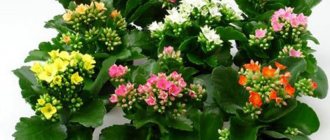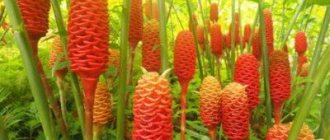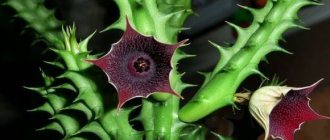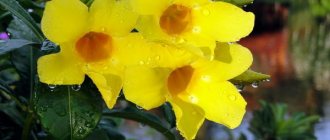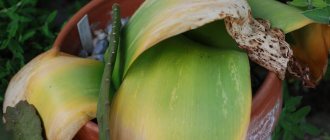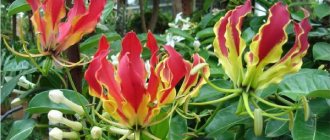Echinopsis or Echinopsis belongs to the Cactus family. The plant got its name due to its appearance, which translates to “hedgehog-like.” If you look at a photo of Echinopsis, you will immediately notice the similarity between it and this animal: it also has a round shape and prickly needles.
However, over time, the cactus begins to stretch upward. The height of some adult shoots can reach almost 2 meters. Subsequently, bright flowers appear on them. As a rule, they are painted in red, pink or white shades. Their diameter can reach 14 centimeters.
Features of the genus
Translated from Greek, its name means hedgehog .
At the beginning of development, these cacti really look like prickly hedgehogs curled up into a ball. Echinopsis have fleshy stems and a powerful root system. The roots are located close to the surface. Their flowers are very large, located on a long, pubescent stalk. Some have a pleasant aroma.
Different species bloom from early spring to late autumn. Each flower lives in bloom for only a day or two.
The number of flowers on a plant reaches 20-25 pieces . They produce a red or yellowish fruit in the shape of a ribbed barrel or ball.
They grow very quickly, the first flowers appear at the age of 3 years . Varietal varieties grow more slowly.
Care
One of the most pressing issues is flower care. Only with careful attention from the owner to the plant can its trouble-free growth be achieved.
Here it is important to take into account the individual characteristics of the cactus and the region of its origin. It appeared in Latin America, which has a hot climate.
This is why the plant loves dryness and warmth. It is noteworthy that in winter you need to move the cactus to a cooler place.
Caring for Echinopsis at home involves abundant watering in the summer and no watering in the winter. In addition, you need to take into account that the cactus does not like humid air.
However, bathing is allowed. In this case, you need to make sure that water does not get on the ground. It is advisable to cover it with a special film. On hot days, you can take the plant to the terrace.
The soil should be slightly acidic. You can purchase it at a specialty store or prepare it yourself. To do this you will need leaf humus, peat, sand and charcoal. It is necessary to place the flower in a shallow pot, because the roots of the plant are located on the surface.
Echinopsis - flowering
Cactus flowers open at night, as in natural conditions this is the time for pollination by bats and moths. Blooming echinopsis pleases the eye for only 1-3 days. The duration of flowering is determined by the air temperature, the number of buds is determined by the age and condition of the plant. Adults can grow up to 25 flowers at a time. The length of the funnels is up to 30 cm, and the diameter is up to 15 cm. At first, a kidney can easily be confused with a baby. In the upper/middle part of the stem, a small fluffy ovary grows in a halo (on the shady side), which turns into a tubeflower in a few days.
Echinopsis cactus blooms with white, pink, purple, yellow, orange, and red flowers. Flowers have many petals. The funnels inside are covered with small hairs. The flower has a large number of pistils with white or yellow light pollen. The peak flowering period for a cactus is the seventh or eighth year of life; it begins to bloom in the third year. When a pet gets old, the flowers become faded, it is rejuvenated: the top is cut off, left for two weeks in the fresh air, and then planted in damp sand until roots appear.
How often does Echinopsis bloom?
Often the Echinopsis cactus in bloom pleases owners with its delicate aroma. You can enjoy the wonderful smell in the summer. Sometimes the buds begin to set in the spring. With proper care (watering and wintering), flowers appear every year. The duration of flowering can reach six months. It happens that echinopsis does not bloom for a long time. The reason lies in inappropriate temperature conditions. The plant needs to be provided with hot summers and cold winters.
Transfer
Echinopsis requires regular replanting. Young cactus - annually, adult - once every 24 months. The process is not particularly complicated.
The plant has very strong roots, so you don’t have to worry about damaging them. Experts recommend washing the cactus with hot water as part of the transplant.
Echinopsis - reproduction
The Echinopsis cactus does not reproduce vegetatively, although there is such a widespread belief. In order to prevent degeneration of the flower, it must be propagated by seeds. Although the first method is the easiest and everyone uses it, self-sterile echinopsis “forgets” over time how to bloom. If you want to get a blooming and beautiful specimen, stock up on seeds and patience. When propagating from seeds, the wait for flowering takes a long time. The egg-shaped fruits of Echinopsis are set after flowering. Black, smooth, shiny seeds ripen in them.
To germinate, seeds are soaked in water at room temperature, then sown in a regular substrate for succulents. Covered in glass and at room temperature, the seeds germinate quickly. Moisten the soil as it dries. When the seedlings appear, they are not covered, allowing them to grow. Grown echinopsis are planted in separate flowerpots. This type of cactus is solitary.
Echinopsis are cross pollinated. To obtain seeds you need two cacti with different genetics. Fruits will not grow if you cross-pollinate cacti grown from the same mother plant. Some gardeners successfully pollinate Echinopsis with pollen from other species of cacti that bloom at the same time. Sometimes pollen is collected from a flowering plant and stored in the refrigerator for up to 2 months, after which it loses its ability to pollinate. The fruit ovary is not immediately visible, only as the flower tube dries.
Echinopsis babies
When propagated by shoots, the plant grows identical to the mother in appearance. To reproduce, the babies are cut with a sterile instrument, the cut is allowed to dry and then planted in the substrate. If the new plant already has budding roots, then it is planted immediately. The soil for the plant should be light. First, drainage is placed in the flowerpot, and then a mixture is poured, which includes humus, sand, peat and leaf soil. You can just use sand and soil. The Echinopsis flower requires removal of the children if they have grown greatly, so that the mother plant can bloom more.
Often cacti become inhabitants of offices and settle near computers, so even busy people can grow such a flower. The Echinopsis cactus is difficult to kill, but certain care skills are required to make it bloom repeatedly and thickly. This plant needs to create conditions close to its native hot climate: with sufficient watering, plenty of light and fresh air.
Possible problems
One of the most common difficulties faced by gardeners is the appearance of rotten areas on the rhizomes and trunk of Echinopsis. All this is a consequence of improper care. However, even in this case, the situation can be corrected. The affected areas must be removed and proper follow-up care provided.
Cacti can also be susceptible to pests. Echinopsis tends to attract mealybugs and spider mites.
The modern assortment in specialized stores provides a wide selection of means to combat parasites.
Diseases and pests
Echinopsis is extremely resistant to diseases and pests. The most common problem that worries gardeners is rot . It appears when there is excess moisture in the soil.
spider mites are sometimes found . This bug feeds on the sap of the plant, leaving behind thin cobwebs. To get rid of it, as a rule, washing with soapy water is enough. If this does not help, then they resort to acaricides, for example, Fitoverm. When choosing a drug, please note that some of them are very toxic and are not intended for use indoors.
The lack of flowering of Echinopsis is one of the most common problems that bother gardeners. The thing is that in order to bloom, a cactus must adhere to the temperature regime, namely warmth in the summer and a decrease in temperature in the winter. Also, lack of flowering is possible due to lack of lighting or excess moisture and decay.


